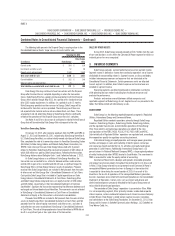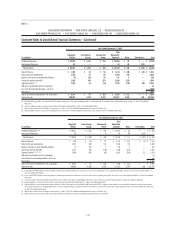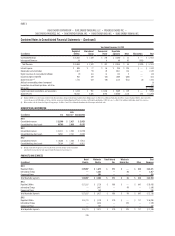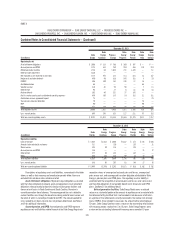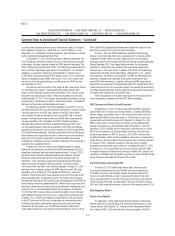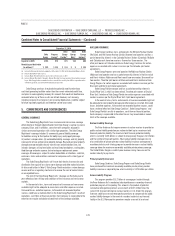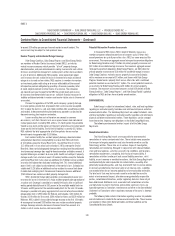Duke Energy 2014 Annual Report Download - page 144
Download and view the complete annual report
Please find page 144 of the 2014 Duke Energy annual report below. You can navigate through the pages in the report by either clicking on the pages listed below, or by using the keyword search tool below to find specific information within the annual report.
124
PART II
DUKE ENERGY CORPORATION • DUKE ENERGY CAROLINAS, LLC • PROGRESS ENERGY, INC. •
DUKE ENERGY PROGRESS, INC. • DUKE ENERGY FLORIDA, INC. • DUKE ENERGY OHIO, INC. • DUKE ENERGY INDIANA, INC.
Combined Notes to Consolidated Financial Statements – (Continued)
Energy Florida’s decommissioning study assumes Crystal River Unit 3 will be
in SAFSTOR confi guration, requiring limited staffi ng to monitor plant conditions,
until the eventual dismantling and decontamination activities to be completed
by 2073. This decommissioning approach is currently utilized at a number of
retired domestic nuclear power plants and is one of three accepted approaches
to decommissioning approved by the NRC.
Duke Energy Florida has reclassifi ed all Crystal River Unit 3 investments,
including property, plant and equipment, nuclear fuel, inventory, and other
assets, to a regulatory asset. Duke Energy agreed to forgo recovery of
$295 million of regulatory assets and an impairment charge was recorded in
the second quarter of 2013 for this matter. Duke Energy Florida is allowed to
accelerate cash recovery of approximately $130 million of the Crystal River
Unit 3 regulatory asset from retail customers from 2014 through 2016 through
its fuel clause. Duke Energy Florida will begin recovery of the remaining
Crystal River Unit 3 regulatory asset, up to a cap of $1,466 million from retail
customers upon the earlier of (i) full recovery of the uncollected Levy investment
or (ii) the fi rst billing period of January 2017. Recovery will continue 240 months
from inception of collection of the regulatory asset in base rates. The Crystal
River Unit 3 base rate component will be adjusted at least every four years.
Included in this recovery, but not subject to the cap, are costs of building an
independent spent fuel storage installation (ISFSI). The return rate will be based
on the currently approved AFUDC rate with a return on equity of 7.35 percent, or
70 percent of the currently approved 10.5 percent. The return rate is subject to
change if the return on equity changes in the future. In December 2014, the FPSC
approved Duke Energy Florida’s decision to construct the ISFSI and approved
Duke Energy Florida’s request to defer amortization of the ISFSI pending resolution
of its litigation against the federal government as a result of the Department of
Energy’s breach of its obligation to accept spent nuclear fuel. The regulatory asset
associated with the original power uprate project to increase generating capacity
will continue to be recovered through the Nuclear Cost Recovery Clause over an
estimated seven-year period that began in 2013.
Through December 31, 2014, Duke Energy Florida deferred $1,377 million
for rate recovery related to Crystal River Unit 3, which is subject to the rate
recovery cap in the 2013 Settlement. In addition, Duke Energy Florida deferred
$260 million for recovery associated with building an ISFSI and the original uprate
project, which is not subject to the rate recovery cap discussed above. Duke
Energy Florida does not expect the Crystal River Unit 3 costs to exceed the cap.
Customer Rate Matters
Pursuant to the 2013 Settlement, Duke Energy Florida will maintain
base rates at the current level through the last billing period of 2018, subject
to the return on equity range of 9.5 to 11.5 percent, with exceptions for base
rate increases for the recovery of the Crystal River Unit 3 regulatory asset
beginning no later than 2017 and base rate increases for new generation
through 2018, per the provisions of the 2013 Settlement. Duke Energy Florida is
not required to fi le a depreciation study, fossil dismantlement study or nuclear
decommissioning study until the earlier of the next rate case fi ling or March 31,
2019. The 2012 Settlement provided for a $150 million increase in base revenue
effective with the fi rst billing cycle of January 2013. Costs associated with
Crystal River Unit 3 investments were removed from retail rate base effective
with the fi rst billing cycle of January 2013. Duke Energy Florida is accruing,
for future rate-setting purposes, a carrying charge on the Crystal River Unit 3
investment until the Crystal River Unit 3 regulatory asset is recovered in base
rates. If Duke Energy Florida’s retail base rate earnings fall below the return on
equity range, as reported on a FPSC-adjusted or pro forma basis on a monthly
earnings surveillance report, it may petition the FPSC to amend its base rates
during the term of the 2013 Settlement.
Duke Energy Florida agreed to refund $388 million to retail customers
through its fuel clause, as required by the 2012 Settlement. At December 31,
2014, $120 million remains to be refunded, of which $50 million credit is
recorded in Regulatory assets within Current Assets as an offset to deferred fuel
and $70 million is recorded in Regulatory liabilities in Deferred Credits and Other
Liabilities on the Consolidated Balance Sheets.
Levy
On July 28, 2008, Duke Energy Florida applied to the NRC for a COL
for two Westinghouse AP1000 reactors at Levy. In 2008, the FPSC granted
Duke Energy Florida’s petition for an affi rmative Determination of Need and
related orders requesting cost recovery under Florida’s nuclear cost-recovery
rule, together with the associated facilities, including transmission lines and
substation facilities. Design changes have been identifi ed in the Westinghouse
AP1000 certifi ed design that must be addressed before the NRC can complete
its review of the Levy COL application. These design changes set the schedule
for completion of the NRC COL application review and issuance of the Levy COL.
Based on the current review schedule, the Levy COL is currently expected by
mid-2016.
On January 28, 2014, Duke Energy Florida terminated the Levy
engineering, procurement and construction agreement (EPC). Duke Energy
Florida may be required to pay for work performed under the EPC and to bring
existing work to an orderly conclusion, including but not limited to costs to
demobilize and cancel certain equipment and material orders placed. As of
December 31, 2014, Duke Energy Florida has recorded an exit obligation of
$25 million for the termination of the EPC. This liability was recorded within
Other in Deferred Credits and Other Liabilities with an offset primarily to
Regulatory assets on the Consolidated Balance Sheets. Duke Energy Florida is
allowed to recover reasonable and prudent EPC cancellation costs from its retail
customers.
The 2012 Settlement provided that Duke Energy Florida include the
allocated wholesale cost of Levy as a retail regulatory asset and include this
asset as a component of rate base and amortization expense for regulatory
reporting. In accordance with the 2013 Settlement, Duke Energy Florida ceased
amortization of the wholesale allocation of Levy investments against retail rates.
In the second quarter of 2013, Duke Energy Florida recorded a pretax charge of
$65 million to write off the wholesale portion of Levy investments. This amount
is included in Impairment charges on Duke Energy Florida’s Statements of
Operations and Comprehensive Income.
On October 27, 2014, the FPSC approved Duke Energy Florida rates
for 2015 for Levy as fi led and consistent with those established in the 2013
Revised and Restated Settlement Agreement. Recovery of the remaining retail
portion of the project costs may occur over fi ve years from 2013 through
2017. Duke Energy Florida has an ongoing responsibility to demonstrate
prudency related to the wind down of the Levy investment and the potential
for salvage of Levy assets. As of December 31, 2014, Duke Energy Florida has
a net uncollected investment in Levy of approximately $180 million, including
AFUDC. Of this amount, $91 million related to land and the COL is included in
Net, property, plant and equipment and will be recovered through base rates
and $89 million is included in Regulatory assets within Current Assets on the
Consolidated Balance Sheets and will be recovered through the NCRC.


